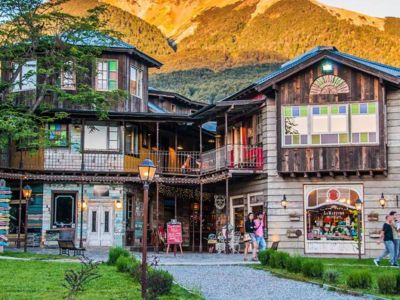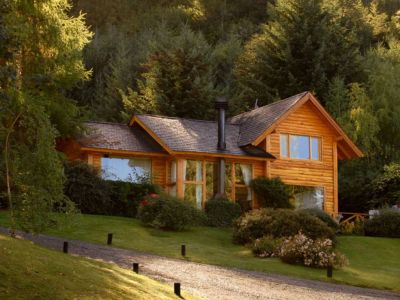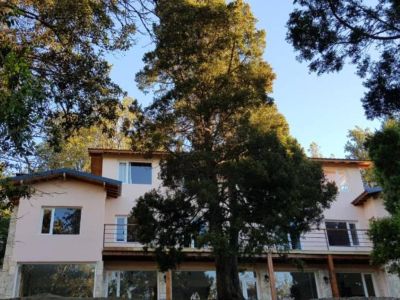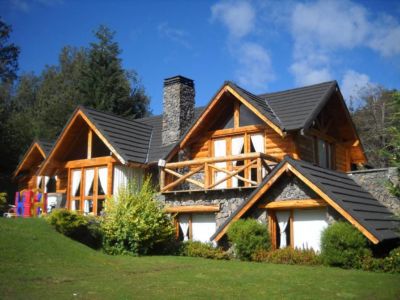To the Southeast of the Quetrihué Peninsula, lies a natural treasure of the Los Arrayanes National Park. On the shores of Lake Nahuel Huapi, about 12 hectares concentrate magnificent giant myrtaceous bushes, best known as myrtles. From the mapuche term ketri, “myrtle” and hué, “site”, the forest of the peninsula has certain features that make it unique in the world: its specimens reach over 15 meters of height and 400 years of age. As ancient as they are beautiful, their thick trunks are covered by soft thin sheets that make up the cold bark dyed in a delicate cinnamon color. During the summer season, its small exquisite white flowers ornament its branches to give way to the blackish violet edible fruit of the Fall, used by the Indians to prepare chicha (alcoholic beverage).
Lake Tour to the Myrtle-tree Forest
Sailing along the quiet waters of the lake to this magical nook is amazing and bewitching at any time of the year. On board the Futaleufú, the catamaran setting sail from the Villa La Angostura harbor goes up the Nahuel Huapi course in the Mansa Bay. In the Northern area of the peninsula, the cypresses, coihues, radales and ñires grow, as well as the notros, michay, chapeles and ciruelillos, which form thick bushes together with the caña colihue. On the shores of the lake, you may watch the great grebes and black-crowned night herons having a rest as you pass by, while the Balsas, Cumelén and Manzano Bays are crossed, till you get to the Quetrihué harbor. Ni bien se desciende del catamarán, el encanto de los arrayanes distingue el paisaje. Como en los cuentos fantásticos, los imponentes portes con sus caprichosas formas de llamativo marrón rojizo, se asemejan a los escenarios de duendes y elfos. Para no interferir el frágil equilibrio de la naturaleza, los senderos construidos en plataformas de madera marcan el recorrido, realizado junto a los guías que muestran las diferentes etapas del crecimiento del arrayán y su convivencia con otras especies de vegetales y animales. Small water courses coming from the Hua-Huan Lagoon, which name derives from a local tree which aroma is similar to the laurel, cross our path. También se distingue la laguna Patagua, que toma su nombre de otra especie arbórea típica de zonas pantanosas, conocida por su corteza que, reducida a polvo, es utilizada como cicatrizante en la medicina popular. En este espejo de agua conviven patos biguá, vapor y gallareta con otras aves como el pájaro carpintero, el zorzal patagónico, rayaditos y chucaos, que se dejan ver si se transita en silencio. El camino se interna en el bosque hasta una cabaña de madera construida en el año 1933. La Casita de Té es también conocida como la casita de Bambi, porque se cree que fue en este lugar donde Walt Disney se inspiró para crear este maravilloso y tierno personaje. Mientras juega con los recuerdos infantiles, la casa invita a tomar chocolate caliente con una porción de riquísima torta. Likewise, the Patagua Lagoon stands out, which adopts its name from another tree species typical of the swamp areas, well-known for its bark which, when reduced to powder, is used as a healing product by popular medicine. In this water mirror, biguá ducks, steamer ducks and coots coexist with other birds such as the woodpecker, the austral thrush, rayaditos and chucaos, which you can see if you move in silence. The path gets deep into the forest towards a wooden cabin built in 1933. The Casita de Té (Tea House) is also known as Bambi’s house, as it is believed that it was there where Walt Disney got inspired to create this marvelous and tender character. As it plays with memories from childhood, the house invites with a cup of hot chocolate with a piece of delicious cake. The magic and beauty of the environment leave their mark, which accompanies us in our way back to Villa La Angostura. Just like awakening from a beautiful childhood dream.
Karina Jozami
Eduardo Epifanio
Contact of the excursion or tour
Greenleaf - Bosque de Arrayanes
Av. Siete Lagos 118 Piso 1 Of C, Villa La Angostura, Neuquén, Argentina
Phone: +54 294-494004
Remember that this is a protected area and, as such, the regulated by National Parks must be complied by so that the environment is not altered.
The lake excursion leaves from the La Mansa Bay harbor, heading for the Quetrihué harbor. It can also be reached along the Arrayanes National Park main path, which crosses the entire peninsula to the forest.
































